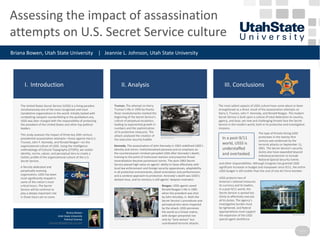Signaler
Partager
Télécharger pour lire hors ligne

Recommandé
Recommandé
Contenu connexe
Tendances
Tendances (20)
A purview into the historical development of terriorism in nigeria

A purview into the historical development of terriorism in nigeria
Terrorism a new challenge to nigeria`s stability in the 21st century

Terrorism a new challenge to nigeria`s stability in the 21st century
Terrorism and the Press class notes by Dr. Plexico

Terrorism and the Press class notes by Dr. Plexico
WAR ON IRAQ IN THE LIGHT OF DEMOCRATIC PEACE THEORY

WAR ON IRAQ IN THE LIGHT OF DEMOCRATIC PEACE THEORY
Liberalist approach to the Iraq War and the War on Terror

Liberalist approach to the Iraq War and the War on Terror
Similaire à Research on Capitol Hill
Similaire à Research on Capitol Hill (14)
Role of CIA in Changing Strategic Operations of CIA

Role of CIA in Changing Strategic Operations of CIA
Chapter 5 Global TerrorismNONSTATE ADVERSARIES, FUNDAMENTALIST.docx

Chapter 5 Global TerrorismNONSTATE ADVERSARIES, FUNDAMENTALIST.docx
MHS 5201, Weapons of Mass Destruction 1 Course Learni.docx

MHS 5201, Weapons of Mass Destruction 1 Course Learni.docx
11.challenges of global terrorism strategies, dimensions and response in sea...

11.challenges of global terrorism strategies, dimensions and response in sea...
Challenges of global terrorism strategies, dimensions and response in search...

Challenges of global terrorism strategies, dimensions and response in search...
Heritage Foundation Report: 40 years of terror trend

Heritage Foundation Report: 40 years of terror trend
Research on Capitol Hill
- 1. Assessing the impact of assassination attempts on U.S. Secret Service culture Briana Bowen, Utah State University | Jeannie L. Johnson, Utah State University Briana Bowen Utah State University Political Science b.bowen@aggiemail.usu.edu I. Introduction II. Analysis III. Conclusions Please leave this spacefree for a Poster Number The United States Secret Service (USSS) is a living paradox: simultaneously one of the most recognized and most clandestine organizations in the world. Initially tasked with combatting rampant counterfeiting in the postbellum era, USSS was later charged with the responsibility of protecting the president of the United States and other top political leaders. This study assesses the impact of three key 20th century presidential assassination attempts––those against Harry S. Truman, John F. Kennedy, and Ronald Reagan––on the organizational culture of USSS. Using the intelligence methodology of Cultural Topography (CTOPS), we isolate identity, norms, values, and perceptual lens to create a holistic profile of the organizational culture of the U.S. Secret Service. Truman. The attempt on Harry Truman’s life in 1950 by Puerto Rican revolutionaries marked the beginning of the Secret Service’s culture of perpetual escalation, leading to exponential growth in numbers and the sophistication of its protective measures. The attack catalyzed the creation of the executive security bubble. USSS protects two of America’s national treasures: its currency and its leaders. In a post-9/11 world, the Secret Service is spread too thinly to effectively execute all its duties. The agency’s investigative burden must be lightened, and federal appropriations must support the expansion of the USSS special agent workforce. A fiercely dedicated and perpetually evolving organization, USSS has been most significantly shaped in some of the nation’s most critical hours. The Secret Service will be continue to play a deeply important role in those hours yet to come. The most salient aspects of USSS culture have come about or been strengthened as a direct result of the assassination attempts on Harry S. Truman, John F. Kennedy, and Ronald Reagan. The modern Secret Service is built upon a culture of total dedication to country, agency, and duty; yet new and challenging threats face the Secret Service in the modern world, both in its protective and investigative missions. President Reagan, flanked by SAIC Jerry Parr, waves moments before being shot by Hinckley. Photo Credit: Wikimedia Commons Reagan. USSS agents saved Ronald Reagan’s life in 1981 when the president was shot by John Hinckley, Jr. Both the Secret Service’s procedures and perceptual lens were impacted by the attack. USSS perceives the world as a threat matrix, with danger presented not only by “lone wolves” but coordinated terrorist attacks. Kennedy. The assassination of John Kennedy in 1963 redefined USSS’s identity and norms. Institutionalized paranoia and an emphasis on the counterassassin mindset pervaded USSS after Kennedy’s death; training to the point of instinctual reaction and proactive threat neutralization became paramount norms. The post-1963 Secret Service placed high value on agents’ ability to liaise effectively with local law enforcement and foreign security apparatuses, adaptability in all protective environments, detail-orientation and perfectionism, and a cerebral approach to protection. Kennedy’s death was USSS’s darkest hour, and its memory is still agents’ deepest motivator. In a post-9/11 world, USSS is understaffed and overtasked. The type of threats facing USSS protectees in the twenty-first century was evidenced by the terrorist attacks on September 11, 2001. The Secret Service’s security duties also have expanded beyond individual protection to include National Special Security Events and other responsibilities. Although Congress has granted USSS significant increases in budget and manpower since 9/11, the entire USSS budget is still smaller than the cost of one Air Force bomber. Special Agent Clint Hill rushes to the aid of President Kennedy after shots arefired. Photo Credit: Wikimedia Commons. Photo Credit: Briana D. Bowen Photo Credit: Briana D. Bowen Photo Credit: Wikimedia Commons